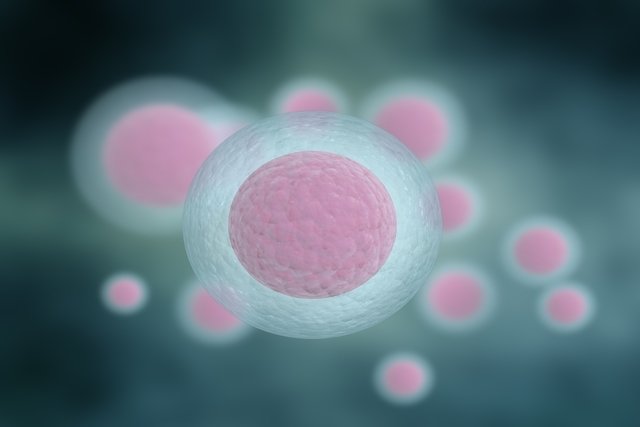Stem cells are cells that can differentiate into various types of cells in the body, during the embryo formation phase and also during growth and adult life, as they have the capacity for self-renewal, resulting in specialized cells responsible for specific functions in the body.
Thus, stem cells are capable of differentiating into blood, muscle, heart, bone or central nervous system cells, for example, constituting various body tissues with specialized functions.
Due to their capacity for self-renewal and differentiation, stem cells can be used in the treatment of various diseases, such as Alzheimer’s disease, Parkinson’s disease, myelofibrosis, thalassemia or sickle cell anemia, for example.

Types of stem cells
Stem cells can be classified into three main types:
1. Embryonic stem cells
Embryonic stem cells are formed at the beginning of the embryo’s development, being the first cells formed after fertilization, and have a great capacity for differentiation and specialization.
There are two types of embryonic stem cells, pluripotent stem cells, which can transform into any tissue and organ in the body, and totipotent stem cells, which give rise to extraembryonic tissues and the placenta.
2. Stem cells adult
Adult stem cells, or non-embryonic stem cells, are cells that have not undergone the differentiation process and are responsible for renewing all tissues in the body. This type of cell can be found anywhere in the body, but mainly in the umbilical cord and bone marrow.
Adult stem cells can be differentiated into two large groups, hematopoietic stem cells, which are responsible for giving rise to blood cells, and mesenchymal stem cells, which give rise to cartilage, muscles and tendons, for example.
3. Pluripotent stem cells
Pluripotent stem cells are induced stem cells, which are produced in the laboratory with cells from embryos at the blastocyst stage.
Pluripotent stem cells can specialize into any type of cell in the body, and therefore can be used in the treatment of diseases to regenerate or repair tissues and organs.
Diseases that can be treated with stem cells
Stem cells can be used to treat various diseases, such as:
- Metabolic diseasessuch as obesity, diabetes, liver disease, metachromatic leukodystrophy, Günther syndrome, adrenoleukodystrophy, Krabbe disease and Niemann Pick syndrome, for example;
- Immunodeficienciessuch as hypogammaglobulinemia, rheumatoid arthritis, chronic granulomatous disease, and X-linked lymphoproliferative syndrome;
- Hemoglobinopathieswhich are diseases related to hemoglobin, such as thalassemia and sickle cell anemia;
- Bone marrow-related deficiencieswhich is the place where stem cells are produced, such as aplastic anemia, Fanconi disease, sideroblastic anemia, Evans syndrome, paroxysmal nocturnal hemoglobinuria, juvenile dermatomyositis, juvenile xanthogranuloma and Glanzmann disease, for example;
- Oncological diseasessuch as acute lymphoblastic leukemia, chronic myeloid leukemia, Hodgkin’s disease, myelofibrosis, acute myeloid leukemia and solid tumors, for example.
In addition to these diseases, stem cell treatment can also be beneficial in cases of osteoporosis, heart disease, Alzheimer’s, Parkinson’s, thymus dysplasia, head trauma and cerebral anoxia, for example.
Due to advances in scientific research, stem cell treatment has been tested in several other diseases and may be made available to the population if the results are positive.
How stem cell treatment is performed
Stem cell treatment must be carried out in a hospital or clinic specialized in this type of procedure and is carried out by applying stem cells directly to the blood of the person undergoing treatment, resulting in the stimulation of the immune system and the formation of specialized cells.
The stem cell used is normally collected after birth, remaining frozen in a laboratory specialized in histocompatibility and cryopreservation or in a public bank through the BrasilCord Network, where the stem cells are donated to society.
Why save stem cells?
Due to the possibility of being used in the treatment of various diseases, stem cells can be collected and preserved at very low negative temperatures, allowing them to be available at any time for around 20 to 25 years, so that they can be used by the baby or by the family when necessary.
The process of collecting and storing stem cells is called cryopreservation and the desire to collect and preserve these cells must be informed before delivery. After birth, the baby’s stem cells can be obtained from blood, umbilical cord or bone marrow.
Cryopreserved cells are normally stored in laboratories specialized in histocompatibility and cryopreservation, which generally provide paid plans for cell preservation for 25 years, or in a public bank through the BrasilCord Network program, in which the cells are donated to society, which can be used for the treatment of diseases or research.
Advantages of saving stem cells
Saving stem cells from the baby’s umbilical cord can be useful for treating illnesses that the baby or his or her immediate family may have. Thus, the advantages of cryopreservation include:
- Protect the baby and the family, If there is a need to transplant these cells, their conservation reduces the chances of rejection for the baby, and there is also the possibility that they can be used to treat a direct family member who may need it, such as a sibling or cousin, for example;
- Allows immediate availability of cells for transplantation if necessary;
- Simple and painless collection methodbeing carried out immediately after birth and does not cause pain to the mother or the baby.
The same cells can be obtained through bone marrow, but the chances of finding a compatible donor are lower, in addition to the procedure to collect the cells being risky, requiring surgery.
Cryopreservation of stem cells during childbirth is a service that can be costly and the decision whether or not to use this service should be discussed with the doctor, so that new parents can make the best decision for their baby.
Furthermore, stem cells are not only used to treat future diseases that the baby may have, but they can also be used to treat diseases of direct family members, such as a brother, father or cousin.

Sign up for our newsletter and stay up to date with exclusive news
that can transform your routine!
Warning: Undefined array key "title" in /home/storelat/public_html/wp-content/plugins/link-whisper-premium/templates/frontend/related-posts.php on line 12
Warning: Undefined array key "title_tag" in /home/storelat/public_html/wp-content/plugins/link-whisper-premium/templates/frontend/related-posts.php on line 13



